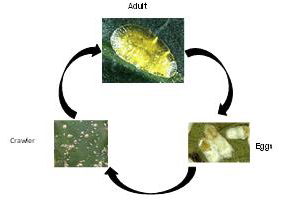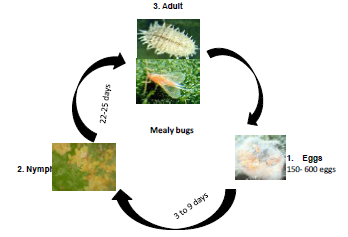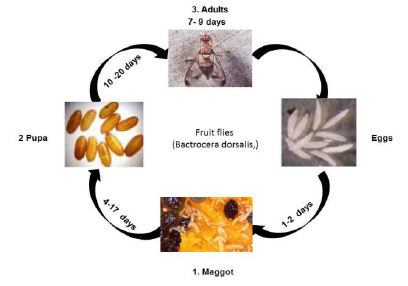Sapota Insect Pests
Sapota Insect Pests
Leaf webber
Biology- Egg: Freshly laid eggs were soft, pale yellow but semi-transparent and fertile eggs turned pink within 24 hrs. Eggs are laid usually in small batches of 4 to 30 along the mid rib of the underside of leaf or tender branches.
- Larva: neonate larvae measured 1.35 mm in length. Initially it is pink and become yellow within 24 h and later turns into greenish in colour. Head is pale yellow. Dorsal side of body is pink in colour while ventral side is green. First and third pair of strips are pink in colour blended with black spots on each segment while second pair is purple.
- Pupa: Pupation takes place in plant debris or in soil.
- Adult: Adult is grayish in colour with compound black eyes with setaceous antennae. Fore wings are grayish with four black transverse wavy lines. Hind wings are membranous white. Both the wings are fringed at the outer margins. A brownish line is present near the outer margins of the wings.
Caterpillar webs and feed on leaves by scrapping chlorophyll content Caterpillar also bores into flower buds and tender fruits leading to withering and shedding.
Green scale
- Egg: Eggs are whitish green and elongate-oval and are laid singly and hatch beneath the female where they are protected. Eggs hatch from a few minutes to several hours after being laid.
- Nymphs (Crawlers): Nymphs, or immature green scales are oval, flat and yellowish green in color, and have six short legs. There are three nymphal stages before becoming an adult, each stage being larger and more convex than the previous stage.
- Adults: The adult female is shiny pale green with a conspicuous black, irregular U-shaped internal marking that is dorsally visible to the naked eye. Two sub-marginal black eye spots are also present and can be seen with a hand lens. The outline shape may be described as elongate- oval and moderately convex. Adult scales are 2.5-3.25 mm. Dead scales are light brown or buff color and the black internal marking is lost.
Life cycle:

Nature and symptoms of damage:
Scales damage plants by sucking out plant sap as a result leaves to yellow and wilt.
Natural enemies of scale insects:- Parasitoids: Coccophgagus cowperi
- Predators: C. montrouzieri
Striped mealy bug
Biology: Mealy bugs are soft pinkish-white insects with a waxy appearance. Adult females are soft-bodied, wingless insects that grow between 1/20 and 1/5 inch long. Mealy bugs lay large clusters of several hundred eggs on the surface of a leaf, which then hatch into yellow nymphs, which feed on plant sap

- Parasitoids: Parasitic wasp
- Predators: Hover flies, ladybird beetle, Cryptolaemus montrouzieri
Fruit fly
Biology- Egg: The eggs of Bactrocera species are very similar. Size, 0.8 mm long, 0.2 mm wide, with the micropyle protruding slightly at the anterior end. The chorion is reticulate (requires scanning electron microscope examination). White to yellow-white in colour.
- Maggot: The third-instar, which has a typical maggot appearance, is about 10 mm in length and creamy white. The only band of spinules encircling the body is found on the first segment. The external part of the anterior respiratory organs, the spiracles, located one on each side of the pointed or head end of the larva, has an exaggerated and deflexed lobe at each side and bears many small tubercles. The caudal segment is very smooth. The posterior spiracles are located in the dorsal third of the segment as viewed from the rear of the larva. The mature larva emerges from the fruit, drops to the ground, and forms a tan to dark brown puparium about 4.9 mm in length. The entire larval stage lasts for 11-15 days.
- Pupa: When mature, larvae drop to the ground and pupate in the soil. The puparium is yellowish-brown and seed-like. Adults emerge in about 10 days.
- Adult: Generally, the abdomen has two horizontal black stripes and a longitudinal median stripe extending from the base of the third segment to the apex of the abdomen. These markings may form a "T" shaped pattern, but the pattern varies considerably. Females begin to lay eggs about 8 days after emergence from the puparium. Under optimum conditions, a female can lay more than 3,000 eggs during her lifetime, but under field conditions approximately 1,200 to 1,500 eggs per female is considered to be the usual production.Ripe fruit are preferred for egg laying, but immature ones may be also attacked.
Life cycle:

Symptoms of damage:
- Maggot bore into semi-ripen fruits with decayed spots and dropping of fruits.
- Oozing of fluid
- Brownish rotten patches on fruits
Parasitoids: Fopius arisanus, Diachasmimorpha kraussi
Bud borer
Biology:- Eggs: The eggs of A. achrasella were smooth, oval and white in colour at the time of oviposition and turned to light brown before hatching. The length of eggs ranged from 0.37 to 0.49 mm with an average of 0.46 ± 0.04 mm, while the breadth varied from 0.20 to 0.29 mm with an average of 0.25 ± 0.03 mm. The incubation period varied from 4 to 6 days with an average of 4.64 ± 0.70 days.
- Larva -. The larva is small, slender, pinkish brown with black head and passed through four instars on sapota buds. The newly hatched caterpillar was light yellow in colour, shiny with black head. It was tiny and delicate with slender body.
- Pupa: This pre-pupal condition lasted for about one day during which the larva did not exhibit any movement unless it was disturbed. The prepupal period lasted for 1 to 2 days with an average of 1.52 ± 0.51 days. The length of pre-pupa varied from 6.10 to 7.20 mm with an average of 6.62 ± 0.34 mm, while breadth ranged from 1.61 to 2.10 with an average of 1.41 ± 0.05 mm. A newly formed pupa was obtect type, brick-red in colour and changed into dark brown prior to the emergence as adult. The pupation took place either inside or out side of the flower buds.
- Adult: Grey moth with black patch on wings. The adults development was completed and legs and the wings are clearly visible through the pupal skin under microscope.
- The bud borer webs together flower buds and flowers and reported to cause huge damage ranged from 2-15%.
- The bud borer feeds by making holes into the petals and ovary resulting in significant crop loss.
- Larvae damages inflorescences of the trees
Seed Borer
Bioolgy
- Eggs: A female moth lays eggs on medium sized immature fruits of sapota with the fecundity of 29 to 255 eggs/female.
- Larva: The larvae are very minute, white in colour with pinkish tinge. The larvae feed only on endosperm of the seed and complete its larval period inside the seed. For pupation, the mature larva comes out by tunneling out the fruit which usually coincides with the fruit harvest.
The seed borer is a monophagous pest attacking immature fruits of sapota. A neonate larva bore into the fruit and finally enters the seed. The larvae feed only on endosperm of the seed . Full grown larvae prepare a tunnel to come out for pupation. Due to the infestation of the pest quality of the fruit deteriorates and hence the market price goes down.
IPM for Sapota
To know the IPM practices for Sapota, click here.
Source:NIPHM ; Directorate of Plant Protection, Quarantine & Storage
Last Modified : 4/2/2020
This topic covers the information related to Insec...
This topic covers the information related to insec...
This topic covers information about Ber Insect and...
This topic covers the information related to insec...
